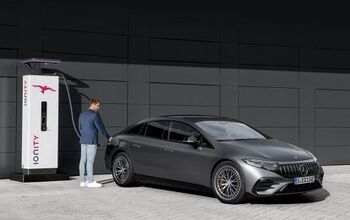Yes, There's a Rotary Engine Coming to a Mazda Vehicle Next Year, but It's Not the Main Event

If you’re prone to daydreaming about slinky roadsters and curvaceous coupes powered by a high-revving rotary engine, this news might disappoint.
Mazda, one of a dwindling handful of automakers not in possession of an electric (or even hybrid) vehicle, plans to change that status next year with the introduction of a small battery-powered car. Coming along for the ride — at least in one variant — is a rotary gas engine designed to go unnoticed by the driver.
Speaking to Dutch outlet ZERauto.nl, Martijn ten Brink, vice president of sales for Mazda Motor Europe, said the electric vehicle and its range-extended sibling will appear in 2019. This jibes with what global powertrain head Mitsuo Hitomi said late last year.
Mazda loves gasoline engines, and internal combustion technology remains the major focus of its long-term planning. The mainly sparkless Skyactiv-X four-cylinder gas engine is proof of this. Still, Mazda can’t shy from technological advancements in the electric car field forever, and the upcoming EV should arrive at the same time as the new crop of fuel-efficient compacts.
Sharing a new Small Car Platform with the next-generation Mazda 2, 3, and CX-3, the unnamed EV will debut with dimensions similar to the 3, possible as a “crossover-like model,” ten Brink said.
For drivers worried about running dry while miles from a plug, Mazda will offer the option of a “a range extender in the form of a wankel engine,” the executive added. As there’s only so much battery space beneath a vehicle designed for all types of propulsion, range and battery size should be mid-pack. Having a rotary on board — one designed solely as a generator — not only eliminates fear of being stranded without a power source in the middle of nowhere, it also broadens the model’s appeal.
Not that sales are a huge consideration. Mazda’s treating the upcoming global model as something of an experiment. “Whether we sell 5,000 or 10,000 of them, we are going to learn a lot from them,” Martijn ten Brink said.
Mounted flat, the rotary generator will reportedly be no larger than a showbox, with related hardware expanding the powerplant’s footprint to that of two shoeboxes. The smooth-running engine, positioned low in the vehicle, should go unnoticed when in operation. (Hardly the spiritual driving experience of past rotaries, but at least it keeps the engine type alive.)
If all this talk of electric vehicles and crossovers has you feeling listless, fear not. There’s still a fire burning at Mazda HQ for a true rotary-powered sports car. Unfortunately, no shortage of uncertainty surrounds this future mystery model, which clearly isn’t at the top of the automaker’s to-do list.
[Image: Mazda]

More by Steph Willems
Latest Car Reviews
Read moreLatest Product Reviews
Read moreRecent Comments
- Mister It wasn't helped any by the horrible fuel economy for what it was... something like 22mpg city, iirc.
- Lorenzo I shop for all-season tires that have good wet and dry pavement grip and use them year-round. Nothing works on black ice, and I stopped driving in snow long ago - I'll wait until the streets and highways are plowed, when all-seasons are good enough. After all, I don't live in Canada or deep in the snow zone.
- FormerFF I’m in Atlanta. The summers go on in April and come off in October. I have a Cayman that stays on summer tires year round and gets driven on winter days when the temperature gets above 45 F and it’s dry, which is usually at least once a week.
- Kwik_Shift_Pro4X I've never driven anything that would justify having summer tires.
- Scotes So I’ll bite on a real world example… 2020 BMW M340i. Michelin Pilot Sport 4S. At 40k now and I replaced them at about 20k. Note this is the staggered setup on rwd. They stick like glue when they are new and when they are warm. Usually the second winter when temps drop below 50/60 in the mornings they definitely feel like they are not awake and up to the task and noise really becomes an issue as the wear sets in. As I’ve made it through this rainy season here in LA will ride them out for the summer but thinking to go Continental DWS before the next cold/rainy season. Thoughts? Discuss.


































Comments
Join the conversation
The rotary has to burn a little oil injected with the gas, to lubricate the apex and side seals. How are they going to account for that? A separate oil reservoir, like a DEF tank?
Recently I drove the Mitsubishi Outlander PHEV and thought it was brilliant but flawed: brilliant as an electric vehicle, and flawed once the noisy, underpowered, fuel-swilling 4-cylinder generator came on. "If it's going to get the same dismal highway MPG as a non-hybrid CUV once the battery's flat anyway," I thought, "then it would be better if they used a butter-smooth Wankel for the generator." Yes, Wankels are hilariously inefficient, but they're vibration free and compact, the better to leave room for the gas tank. Mazda has done this trick before with a Japan-market extended-range electric Mazda 2; if they can do the same in a USEFUL size CUV (CX-5 or larger, Mazda, none of this CX-3 bullpucky) then they will make a real impact. But the world does NOT need another tiny EV.